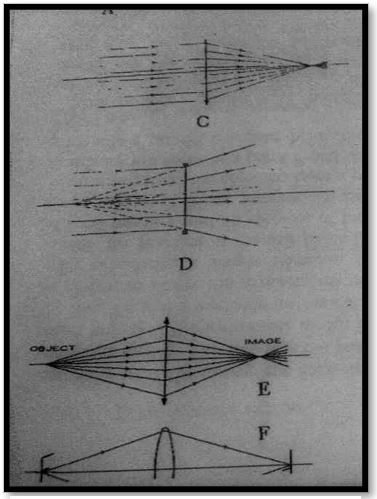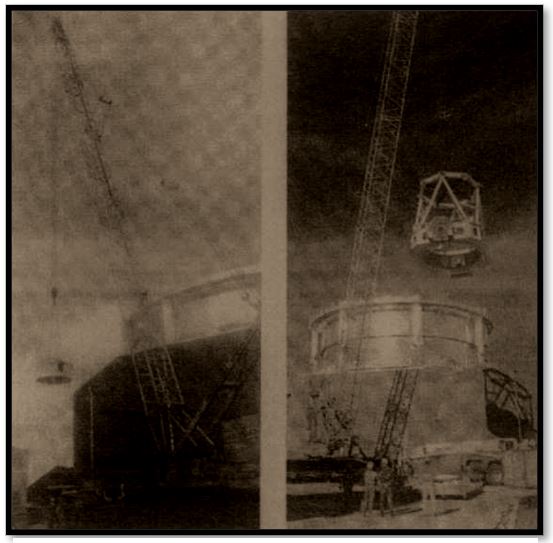Introduction
Since the dawn of time, Man has looked up in to the sky and wondered what is beyond the realms of this planet. This curiosity and interest has pushed man to develop tools and techniques to observe the world not only around him, but also above him. One of these endeavours is telescopes, which have been in use by people since the early 1600s (The Galileo Project, 2008). From using telescopes, time has shown that people have always been interested in observing the sky and the different elements, such as planets, stars and other celestial entities. However, the scope of mere observation has evolved to something much more than just gathering data. This report will study the uses of telescopes and how they have changed over time. There are three researched texts which are going to be used in this report along with different diagrams and illustrations to explain the concepts introduced.
Understanding Telescopes

Positive and Negative Lenses (C) Telescopes are based on the concepts of optics, which deals with the way light interacts within environments. Telescopes are the result of utilising different lenses which capture and project light in certain ways. To understand how telescopes, it is necessary that the concepts behind optics be understood. For that purpose, the introductory text by Page and Page (1966) is an excellent resource, allowing any person interested in telescopes to form a solid understanding.
The concepts of optics form the principles required to understand how optical devices, such as telescopes function. Leveraging the knowledge of lenses, which are pieces of glass with curved surfaces, the book explains how images are formed. There are two types of images formed, positive and negative, which are directly correlated to the focal length of the lens. This is also the reason why lenses are “powered” or “numbered”. The following diagram, illustrates these different types of lenses.
Within the realm of telescopes, there are primarily two different types, namely refractor and reflector telescopes. There are advantages and disadvantages offered by both. Whilst it is not possible to list a detailed argument within the scope of this report, there are then aspects which should be considered when deciding on which kind of telescope of use. These aspects are (i) definition, (ii) achromatism, (iii) magnifying power, (iv) light-gathering power, (v) resolving power, (vi) size of image and usable field, (vii) flatness of field, (viii) versatility, (ix) economy and ease of construction and (x) ease-of-use and maintenance (Page and Page, 1966, p.30).
However, over the course of time, the usage of telescopes has moved from just observation of the stars to data collection in order to better understand the universe.
Evolution in the use of telescopes
To understand the change in the use of telescopes, it is warranted that the evolution in types of telescopes be also investigated. An example of this is the Cassegrainian telescope, which is an evolution from the traditional Newtonian model, is a step towards the evolution in telescopes. The Cassegrainian telescope provides for easy adaption for mounting, thus providing easy angles to view the sky (Page and Page, 1966, p.35). The structure of the Cassegrainian telescope is as below

As can be seen from the example of the Cassegrainian telescope, the improvement in technology and ability of telescopes has ushered a new era of applications that can leverage the abilities of the telescope and the functionality that it provides. This is also because people’s needs have grown from simply looking at the sky to wanting to know more about them as well as about the galaxies that exist beyond the one we live in (Moore 1996, p. 69). Also, over time, there has been the development of a greater understanding of how the sky can be better view, and thus different techniques have been developed based on that (Moore 1996, p. 69).
There now exists a variety of combinations of telescopes which range from very large telescopes to some extremely small ones (Moore 1996, p. 97). These telescopes are predominantly scattered in the northern hemisphere, but recent projects have also resulted in the creation of different telescopes in South America. The reasons behind include ambient light pollution (that comes from cities), the weather (including humidity, visibility) and the geographical location (including elevation, height and relative position on the planet).
As a result of this, several different approaches have been taken and as a result, innovative telescopes have been invented. These telescopes have utilised different aspects of the behaviour of light waves and topics (Moore 1996, p. 71).

These telescopes allow viewers to not only observe what is happening in the sky above them but identify various space objects which add to understanding potential threats to the security of the planet (Duffner 2009, p. 296). The following is a dual-picture of the telescope built in Hawaii.
Interestingly, the application of telescopes has also moved from astronomy to other sectors. Within the defence sector, telescopes evolved from being mere observational points (Duffner 2009, p. 278) to strategic intelligence gatherers (Duffner 2009, p. 279). For example, such telescopes have been developed in different locations across the United States, primarily using Hawaii as an ideal location due to its favourable conditions (Duffner 2009, p. 280).

Some peculiar uses and telescopes
In the past fifty years, there have been outlandish designs of telescopes that have resulted in some very peculiar shapes (Moore 1996, p. 97). These designs are the result of catering to the different challenges has astronomers and star gazers have faced in their pursuit of understanding and viewing celestial entities. Therefore, each of these designs have some sort of rationale, such as clarity of sky, distance from certain celestial bodies, weather conditions, etc (Moore 1996, p. 97 – 100). Some examples of these telescopes include the dome of the Crimean Astrophysical Laboratory in Russia, the 236-inch reflector telescope at Mount Pastukhov in Russia, the Siding Spring Observatory in Australia and the automatic AAT 133-inch telescope facility in the United States.
These different telescopes have been designed to overcome the challenges brought forward by the aspects discussed in the previous sections, and thus creating innovative approaches which allow for clearer, larger and more detailed images of the sky.
Conclusion
Over the years, telescopes have evolved from simple tools to complex machinery that allows us to observe not only what exists in the sky but also their content and properties. Given the evolving needs of man, telescopes have been advanced using technology and several limitations relating to nature, such as visibility, weather, etc have been overcome, sometimes resulting in outlandish designs. The results of these endeavours have allowed man to study the galaxy that he lives in more closely and understand the reasons behind why things are the way they are.
References
Duffner, R. (2009). 3.67 Meter Military Telescope Complex. In D. R, The adaptive optics revolution: a history (pp. 277-280). Albuquerque: University of New Mexico Press.
Moore, P. (1996). Telescopes of Many Kinds. In P. Moore, Eyes on the Universe: the story of the telescope (pp. 97-104). London: Springer.
Moore, P. (1996). The New Telescopes. In P. Moore, Eyes on the Universe: the story of the telescope (pp. 69-74). London: Springer.
Page, T., & Page, L. (1966). Basic Principles. In T. Page, & P. L, Telescopes: how to make them and use them (pp. 16-33). New York: Macmillan.
The Galileo Project. (2008). Telescopes, an Introduction. Web.